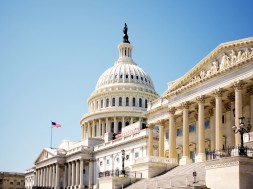
Challenges and Opportunities in Higher Education Reform
By Katherine Brodie, Kristina Gill, Chris Collins, Zach Perlman, Duane Morris LLP, Higher Education Practice Group (Washington, D.C.)
Overview:
This article provides an analysis of the head-spinning, sometimes confounding, and yet hopeful developments we have seen in Washington since the January 2017 start of the 115th Congress and the new Trump Administration. We provide our views on potential reforms in federal higher education law and policy that we may see in this Congress and at the U.S. Department of Education.
The Trump Administration’s Department of Education: A work in progress
Since January, much of the focus of higher education policy wonks has been trained on attempting to discern the vision of Secretary of Education Betsy DeVos for the future of the U.S. Department of Education and its many existing grants, aid, and assistance programs for students and schools. She has certainly become, as she readily admits, a lightning rod for attack from the political left for a variety of reasons.
Secretary DeVos has also stated her desire for Congress to “start fresh” regarding the Higher Education Act of 1965 (“HEA”), which is currently due for reauthorization.
Indeed, she has questioned the value of the existence of the agency she leads and has submitted a Fiscal Year 2018 budget request to Congress that proposes significantly slashing agency personnel and programming. In a sense, she has asserted herself on the national stage as a “change agent” for the federal role in education, but the nature and scope of that change has not yet been articulated clearly, leading to continued uncertainty for stakeholders including states, students, schools (including institutions of higher education), and, not to mention, agency employees.
Short term view
In the short term, the Trump Administration’s overall de-regulation agenda has led to the recent announcement of the initiation of new agency rulemakings for the Gainful Employment and Borrower Defense to Repayment rules applicable to higher education, which will be a significant new agency undertaking for the Secretary and her staff, even if meant to lighten the load for regulated institutions. We may see additional deregulatory initiatives out of the agency in the near term, as well, meant to delay or reform the impact of Obama-era regulation.
Longer term view
As for the longer term, in our opinion it will likely take many more months for the Secretary and her senior staff to define an affirmative federal higher education reform agenda in a manner that will result in concrete legislative proposals for congressional consideration where congressional approval is necessary to implement change that goes beyond agency guidance and new rulemaking. For instance, although the Trump Administration has been vocal on its call for expanded federal support for apprenticeships and short term job skills training programs – for greater alignment of training with industry needs – incorporation of Title IV student aid or other significant federal funding streams for such programs will need careful construction at the agency, congressional approval and buy in, and budget authority to back up policy goals.
That kind of hard policy development work takes time, staff and leadership, which is now just getting established at the Department.
Another good example of the challenge that awaits the Secretary is the recent passage by the House of the Carl D. Perkins Career and Technical Education Act of 2006 (“CTE” bill), which seeks to reauthorize the popular program, but for which the White House proposes reducing funding in its recent agency budget request. Although this is a relatively non-controversial bill that could attain enactment this year, there is more hard work to do to align the Department, the House, the Senate and White House on national CTE goals and funding authority. Other higher education policy goals of this Administration will similarly require consensus on an agenda and hard negotiation to attain.
115th Congress: Steady progress being made on higher education reform
House and Senate Education Committee activity to date
While the Administration continues to get its sea-legs on its education agenda, the 115th Congress has been steadily advancing the ball, particularly in the House Education and Workforce Committee under the new leadership of Chairwoman Virginia Foxx (R-NC) who has proven herself to be an efficient and able leader of that Committee. She has gaveled in at least eight hearings since January 2017 on education and training related issues that have included thoughtful testimony from a variety of experts about the future of workforce preparation and postsecondary education in the United States. A central concern of many of these hearings has been protecting the affordability of and access to postsecondary education, but no consensus has yet developed on how to balance continued broad access to federal student aid for higher education with tighter outcomes accountability and cost controls. The Committee’s 2014 white paper on HEA reform outlines four principles to guide the Committee’s work including:
- Empowering students and families to make informed decisions;
- Simplifying and improving student aid;
- Promoting innovation, access, and completion; and
- Ensuring strong accountability and a limited federal role.
The Senate Health Education Labor and Pensions Committee has been less active this year so far, primarily due to the number of Cabinet nominees that required confirmation hearings early in this Congress. However, the Senate Committee engaged in a tremendous amount of activity last Congress under Chairman Alexander’s leadership, having held a series of Higher Education Act reauthorization hearings on the topics of affordability, innovation, campus safety, accreditation, and improving student outcomes, as well as the release of three white papers on topics of interest to address in HEA including data transparency and consumer information; accreditation; and institutional sharing in the risk of default or non-payment of federal student loans (so-called “skin in the game” proposals). All of that thought analysis remains relevant to the Committee’s deliberations of HEA reform proposals this year.
HEA reauthorization timing
With HEA due for reauthorization, questions continue to revolve around timing and tactics. Committee leadership on the House side has continued to promote a comprehensive reform package that will incorporate the goals related to the above-mentioned principles.
On the question of timing, the Committee is still on track to produce a draft bill by Fall of 2017 with intentions to pass the bill during the 115th Congress.
At this point, we anticipate an early draft in October with possible Committee action before the end of 2017. Consideration by the full House will likely occur in 2018.
On the Senate side, there is still substantial debate surrounding the form of reauthorization. Ideas that have been promoted include multiple stand-alone bills that cover specific aspects of HEA reform, a comprehensive reform bill similar to the House plan, or a hybrid of these options that would start with stand-alone bills and shape them into a single package. The question of form will be largely dictated by the political relationships and the Committee’s firm desire to achieve a bipartisan result. Chairman Lamar Alexander (R-TN) and Ranking Member Patty Murray (D-WA) worked hard to reach consensus on the Every Student Succeeds Act (“ESSA”) and have made clear that they intend to continue working in this collaborative manner. Therefore, timing on HEA on the Senate side is more uncertain. Both the Committee calendar and the floor schedule have been occupied with Senate confirmations and other priority legislation, namely the healthcare bill rehaul. We anticipate that the Senate will first address CTE reform having received the House passed version of the bill recently before moving to HEA.
State of play – legislative proposals
In analyzing where Congress is currently with respect to specific legislative proposals for HEA reform, we have analyzed at least 120 bills of interest that have been introduced thus far in the House and Senate during this Congress. Those bills are clustered into issue sets including veterans’ education, apprenticeships, cybersecurity and privacy, disability rights, student financial aid program or Department of Education institutional reform, civil rights including Title IX, campus safety, university research and development funding, and freedom of speech.
Other than legislation repealing the Obama-era teacher preparation and ESSA regulations that were enacted early in the Congress (using the Congressional Review Act procedures which require only majority vote of the House and Senate), no other higher education related bills have been enacted this Congress.
Below, we summarize legislation introduced to date according to those with primarily Republican sponsorship, primarily Democrat sponsorship, and with bipartisan sponsorship. Because legislation in the Senate still requires at least 60 Senate votes to overcome cloture, achieving bipartisan support for legislative proposals related to HEA reform is still important to easing the enactment of a package or any stand-alone HEA reforms being put forward.
Republican proposals:
Bills introduced to date in this Congress with primarily Republican support and little to no Democrat support would seek to establish clear protections for freedom of speech on campus as a reaction to perceived muzzling of conservative views on liberal campuses; cut administrative cost allowances to institutions of higher education under federal grant programs; terminate the U.S. Department of Education as a federal agency, cut off any federal funding to so-called “sanctuary cities” including universities that harbor illegal immigrants; and authorize investor income share agreements to assist students with financing their education while allowing investors to share in graduate income. We can be sure that none of these highly partisan legislative proposals will garner sufficient support from Democrats to move through the Senate and become law.
Democrat proposals:
Bills introduced in the 115th Congress to date that are supported almost exclusively by Democrats include, but are not limited to, bills that would:
- Safety: Strengthen campus safety (Clery Act); enhance school bus safety; establish campus gun control requirements; and establish greater student protections against violence or harassment;
- Special interest programs: Establish new federally funded programs within the Department for specific purposes including Holocaust education, anti-harassment, rural education, dual enrollment expansion, urban communities, Native American community teacher support; and study abroad;
- Establish free community college through a state and federal support framework;
- Pell Grant program reform: Repeal the prohibition on use of Pell Grants for incarcerated individuals; authorize Pell Grant restoration for successful borrower defense claims; increase the Pell Grant maximum and duration of eligibility; make Pell Grant funding fully mandatory (not subject partially to discretionary annual appropriations); repeal suspension of student eligibility for Title IV aid for drug related offenses; extend Pell eligibility to certain short term programs, and increase federal work study funding support;
- Cost and completion: Mandate credit transfer acceptance from community colleges to 4-year colleges; authorize refinancing of student loans at lower interest rates; provide for 25 percent debt cancellation for graduates of STEM programs;
- Immigration: Ban discrimination on enrollment of students based on immigration or nationality status and provide a FAFSA process for students with parents without social security numbers; and
- Accountability: amend the 90/10 rule to 85/15 by increasing the “10” non-Title IV revenue portion to “15”; amend the 90/10 rule to include DOD and VA funding in the “90” and to adjust the ratio to 85/15; make institutions deemed ineligible for Title IV aid ineligible at the same time for DOD and VA education program participation; amend the HEA to provide for civil penalties and personal liability of owners, officers, and executives of institutions of higher education for regulatory violations; and amend the American Arbitration Act to exclude student enrollment agreements.
These legislative proposals in their current form are not likely to see any action this Congress due to lack of Republican support for ideological or cost reasons.
Bipartisan proposals:
Despite the numerous partisan bills that have been introduced to date, as listed above, there are numerous HEA reform bills that have been introduced that demonstrate a willingness on the part of legislators from both parties to cross the aisle in support of higher education reform proposals. These include, but are not limited to, bills that would:
- Information access and transparency: Increase access to college information for disabled students; develop a federally approved standard format for financial aid offer forms based on recommendations from representatives of students, students’ families, institutions of higher education, secondary school and postsecondary counselors, and nonprofit consumer groups; amend the HEA to require institutions of higher education to provide students with annual estimates of student loan borrowing costs and require the disclosure of the annual percentage rates applicable to federal student loans; establish a postsecondary student data system; provide more accurate, complete, and customizable information for students and families making decisions about postsecondary education; and make changes to the Net Price Calculator;
- Pell Grant program reform: Authorize entities other than accrediting agencies to authorize institutions of higher education to participate in the Pell Grant program according to outcome, performance metrics, and other requirements for skills based programs; authorize the use of Pell Grants for short term job training programs no longer than 150 clock hours over not less than eight weeks; establish a new job training Pell Grant program and to establish greater flexibility with regard to use of Pell Grants for varying types of training programs including apprenticeships; authorize the use of early Pell to permit use of Pell Grant funds for students in high school taking college courses; and authorize the use of Pell Grants for Iraq and Afghanistan veteran dependents;
- Cybersecurity and privacy: Support state cybersecurity protection and amend the Family Educational Rights and Privacy Act of 1974 to prohibit programs administered by the U.S. Department of Education from making funds available to any educational agency or institution that has not implemented information security policies that protect personally identifiable information (PII) from education records;
- Innovation: Amend the HEA to provide demonstration projects for competency-based education and support alternative models to accreditation;
- Computer science: Establish a grant program to promote the development of career education programs in computer science in secondary and postsecondary education through eligible partnerships including institutions of higher education;
- Disability: Amend the HEA to improve veteran service-connected disability determinations for purposes of loan discharge; forgive Parent Plus loans for parents of students who become disabled; establish an independent commission to develop and issue voluntary accessibility guidelines for postsecondary electronic instructional materials and an annotated list of information technology standards for use with disabled students and others;
- Affordability: Amend the HEA to establish more simplified income-driven repayment plans, expand loan deferment and cancellation authorization for specific populations including teachers, entrepreneurs and veterans; enhance student loan counseling requirements; reduce student loan interest rates and permit refinancing at lower rates; require the disclosure of the annual percentage rates applicable to Federal student loans; and allow an employer tax credit for student loan payment assistance.
- Campus safety: Authorize additional enhancements to protections for victims of sexual violence including mandatory Memorandums of Understanding with local law enforcement;
- Veterans education: Authorize the use of Post-9/11 educational assistance funds to pursue study at other than Title IV eligible institutions of higher education; authorize the transfer of unused veteran education benefits to dependents upon death of beneficiary; provide for use of education benefits for costs of licensure and certification tests and college application fees; provide for enhanced educational and vocational counseling; hold veterans harmless from impact on education benefits from school closures; improve service-connected disability determinations for purposes of loan discharge; and improve the administration of the educational assistance programs of the Department of Veterans Affairs;
- Apprenticeships: Provide tax credits for employers hiring apprentices; establish and strengthen projects to defray the cost of instruction associated with pre-apprenticeship and apprenticeship programs; establish a tax credit for on-site apprenticeship programs; and prepare individuals to enter and succeed in an apprenticeship program;
- Foreign medical schools: Amend the HEA to establish fair and consistent eligibility requirements for graduate medical schools operating outside the United States and Canada; and
- Student outcomes: Authorize pay-for-success projects designed to incentivize and reward successful efforts to increase postsecondary education retention and completion rates for low-income and first-generation students.
The House and Senate education committees are currently working on additional HEA amendment proposals with a close eye on those that have bipartisan support sufficient to allow for enactment.
Action item for schools
Stakeholders, including institutions of higher education, individually or collectively through the trade associations to which they belong, should actively engage with Congress regarding HEA reform proposals that will help shape the future of their students and institutions. Even if the timeline for final enactment of a comprehensive HEA reform bill slips into the next Congress, the hard work of crafting policy concepts into legislative proposals and the hard work of building support for those proposals on both sides of the aisle is happening now.
If you are interested in learning more about our federal lobbying practice or receiving copies of our Washington Updates, please contact kdbrodie@duanemorris.com.
KATHERINE D. BRODIE practices in the area of higher education law. Ms. Brodie has over two decades of federal regulatory, legal and policy experience. Since 2009, Ms. Brodie has been focused on the needs of higher education institutions and their partners. Her experience and advice includes issues surrounding compliance with federal, state and accrediting body regulations and standards applicable to postsecondary institutions, including the complex rules governing the Title IV student financial aid programs administered by the U.S. Department of Education.
Ms. Brodie counsels institutions regarding institutional, student and program Title IV program eligibility requirements, program review and audit resolutions, risk management systems and policies, consumer protection regulations, Title IX and Clery Act compliance, and Department of Education change of ownership requirements in the context of school purchases and sale. She also counsels clients regarding federal guidelines governing marketing and recruiting practices, third party vendor relationships, student privacy regulations, student visa, and a variety of other legal and regulatory issues impacting educational institutions of all sizes. As a registered lobbyist for most of her career, Ms. Brodie is active in monitoring and engaging in the federal legislative process on Capitol Hill on behalf of firm clients. She is a frequent speaker at higher education stakeholder gatherings.
Contact Information: Katherine D. Brodie // Special Counsel // Duane Morris LLP // kdbrodie@duanemorris.com // https://www.duanemorris.com/












Comment(2)